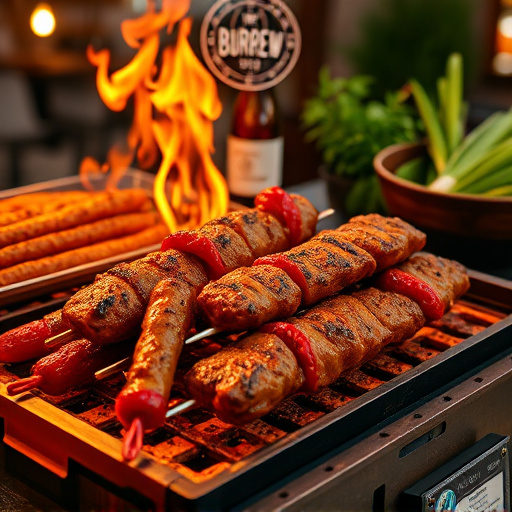Creating a delicious BBQ beef jerky at home involves seasoning (paprika, garlic powder, brown sugar, salt, pepper, chili powder), marinating with liquid smoke or barbecue sauce for several hours or overnight, and slow-drying at low temperatures. Evenly sliced meat (0.6 cm – 1.3 cm thick) ensures uniform cooking, and airtight storage in cool, dry conditions extends shelf life up to 6 months. Customize your rub with spices like chili powder, cumin, cayenne, thyme, rosemary, or oregano for unique flavors, allowing endless creative possibilities.
Unleash your inner chef and explore the art of crafting homemade BBQ beef jerky with a smoky twist! This comprehensive guide takes you on a journey from selecting the perfect cut of beef to seasoning, drying techniques, and even creating a smoking environment in the comfort of your home. Learn the secrets to uniform cutting, storage tips, and endless flavor customization options for your very own mouthwatering BBQ jerky recipe. Get ready to impress with this delicious, homemade treat!
- Choosing the Right Cut of Beef for BBQ Jerky
- Seasoning and Marinade: The Heart of Smoky Flavor
- The Art of Drying: Techniques and Equipment
- Creating a Smoking Environment at Home
- Tips for Cutting and Slicing Jerky Uniformly
- Storage and Shelf Life of Homemade BBQ Beef Jerky
- Customization: Experimenting with Flavors and Spices
Choosing the Right Cut of Beef for BBQ Jerky
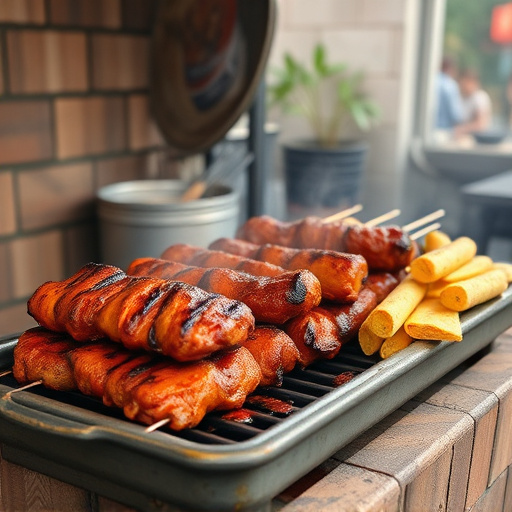
When crafting your homemade BBQ beef jerky with a smoky twist, selecting the perfect cut of beef is half the battle won. For an ideal BBQ jerky recipe, opt for lean cuts like round or flank steak. These cuts tend to be less fatty, ensuring your jerky turns out crisp and not greasy. Lean meat also allows the robust flavors of your smoking process to shine through.
Consider the texture you desire—you want something that’s both chewy and satisfying. Thinly slicing these cuts after they’ve been properly marinated will result in uniform pieces of jerky. This ensures even cooking, so every bite is a delightful blend of smoky, savory, and slightly sweet flavors, hallmarks of a successful BBQ beef jerky recipe.
Seasoning and Marinade: The Heart of Smoky Flavor
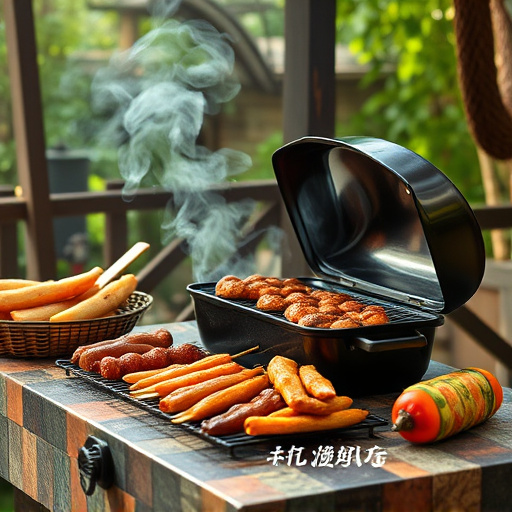
Seasoning and marinade are key elements in crafting a delicious BBQ beef jerky recipe with a smoky twist. The right combination of spices can transform simple beef strips into a mouthwatering snack. Start by mixing your favorite BBQ rub, which often includes paprika, garlic powder, brown sugar, salt, pepper, and chili powder. These ingredients not only add flavor but also help to preserve the meat.
For an extra smoky dimension, incorporate liquid smoke or barbecue sauce into your marinade. Liquid smoke provides a subtle, authentic smoky aroma, while barbecue sauce contributes both sweetness and tanginess. Allow the beef strips to marinate for several hours or even overnight in this flavorful mixture. This process infuses the meat with spices and creates a deep, complex taste that will have you craving more of this homemade BBQ jerky.
The Art of Drying: Techniques and Equipment
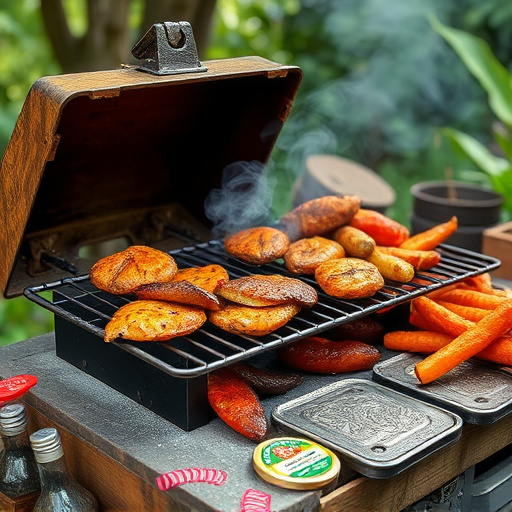
The art of drying meat, specifically for creating jerky, is an ancient practice that has evolved over time. When it comes to crafting a mouthwatering BBQ beef jerky recipe at home, understanding the drying process is key. Traditional methods involve using a dehydrator, which gently removes moisture from the meat, preserving its flavor and texture. This slow-drying process allows for the natural juices and aromas of the beef to concentrate, resulting in a rich, savory jerky experience.
For a smoky barbecue twist, an additional step involves using an oven or a grill with a smoking accessory. By introducing smoke at a lower temperature, you can infuse the jerky with that distinctive BBQ flavor without cooking the meat further. This technique requires precision and patience but offers a unique way to elevate your homemade beef jerky recipe to new heights.
Creating a Smoking Environment at Home
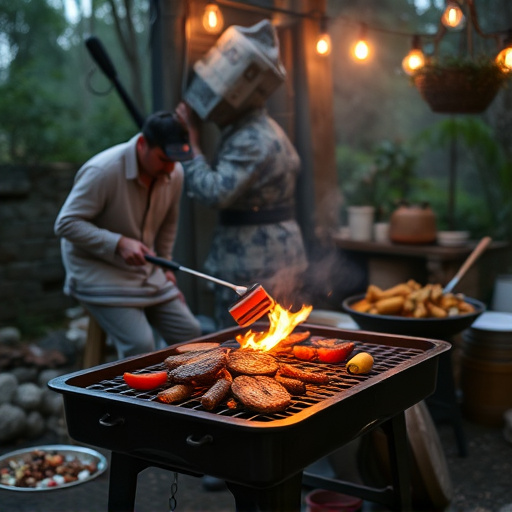
Creating a smoking environment at home for your BBQ beef jerky recipe is all about harnessing the power of low and slow cooking. The simplest way to do this is by using a smoker, whether it’s a dedicated outdoor model or an electric one that can be used indoors. Set your smoker to a temperature between 165-203°F (74-95°C) for the best results—this range ensures a slow, even cook that tenderizes the meat and infuses it with smoky flavor.
For an authentic BBQ jerky experience, consider adding wood chips or chunks to your smoker. Cherry, hickory, or mesquite woods are popular choices known for imparting distinct, delicious flavors. Soak the wood in water for about 30 minutes before adding them to the smoker to prevent excessive smoke and allow time for their flavors to infuse the air. This simple step can transform your homemade jerky into a mouthwatering, smoky delight that rivals any store-bought option.
Tips for Cutting and Slicing Jerky Uniformly
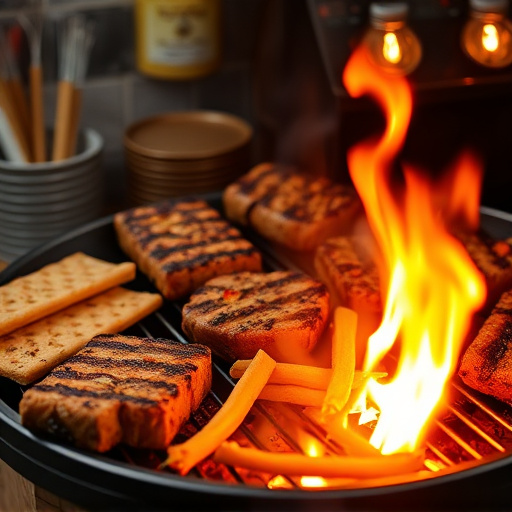
When preparing a bbq beef jerky recipe, achieving uniform slices is key to ensuring even cooking and a delightful texture. Start by selecting a sharp knife designed for slicing meats. A serrated edge can help prevent sticking, making the process smoother. Cut your raw meat into roughly equal-sized pieces before placing them on your cutting board. Aim for thicknesses between 1/4 inch (0.6 cm) and 1/2 inch (1.3 cm) for optimal results in your homemade bbq beef jerky recipe.
To guarantee uniformity, use a meat slicer if available, as it allows for precise control over the slice width. If using a manual method, keep your knife sharp and steady, applying even pressure to ensure consistent thickness throughout the batch. This attention to detail will contribute to the overall quality of your jerky, providing a satisfying experience with every chewy bite.
Storage and Shelf Life of Homemade BBQ Beef Jerky
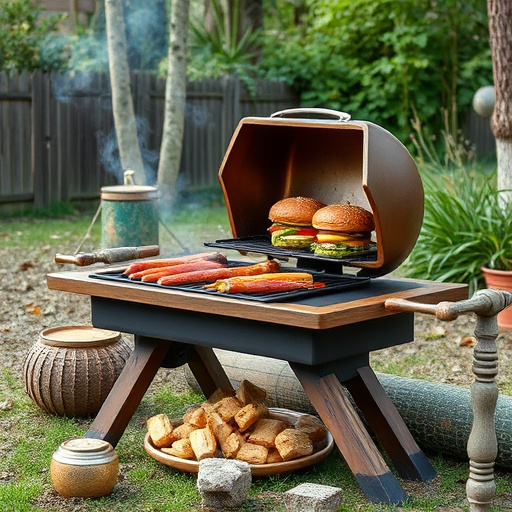
When it comes to storing and preserving your homemade BBQ beef jerky, proper handling is key to maintaining its delicious flavor and texture. This nutritious treat has a relatively long shelf life when kept correctly. It’s recommended to store jerky in an airtight container or vacuum-sealed bag to prevent moisture and oxygen exposure, which can cause spoilage. Ideally, keep it in a cool, dry place; the refrigerator or freezer are excellent options. With proper storage, your BBQ beef jerky recipe can last for several months, ensuring you have a tasty snack on hand whenever cravings strike.
For optimal freshness, consume your homemade jerky within 3-6 months. While it may still be safe to eat after this period, the quality and taste might diminish. Regularly inspect your stored jerky for any signs of spoilage, such as an off odor, mold, or a change in texture. When properly stored, your BBQ beef jerky can be a convenient and healthy on-the-go snack for months to come, allowing you to enjoy the flavors of your culinary creation whenever inspiration strikes.
Customization: Experimenting with Flavors and Spices
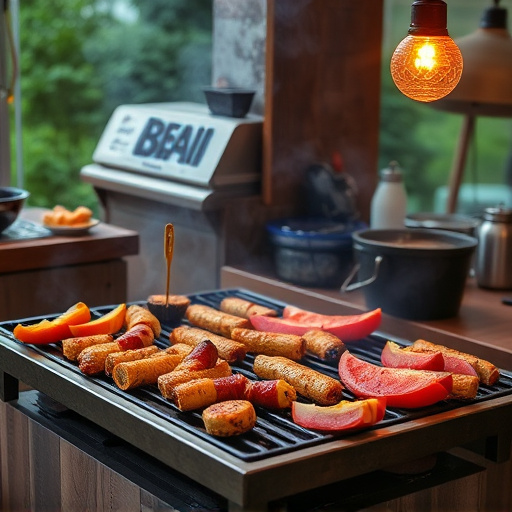
When it comes to creating your own BBQ beef jerky, one of the best parts is the complete customization available. This isn’t just a one-size-fits-all recipe; you have the freedom to experiment with flavors and spices to make it truly your own. Start with a classic BBQ rub comprising brown sugar, paprika, garlic powder, and black pepper. Then, feel free to branch out and add unique twists like chili powder, cumin, or even a touch of cayenne for heat. Herbs such as thyme, rosemary, or oregano can also lend a subtle earthy note. Don’t be afraid to get creative; your palate will guide you towards the perfect combination that satisfies your cravings. With each batch, you’ll refine your technique and develop a signature BBQ beef jerky recipe that’s sure to impress.
